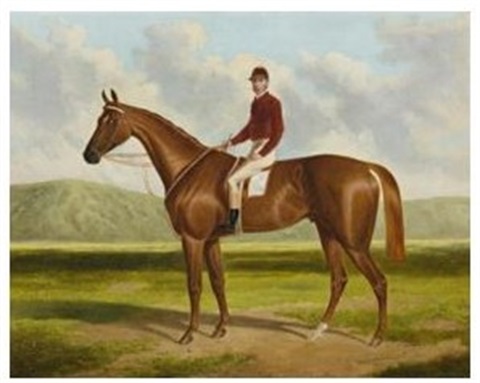West Torrens Streets with Equine Connections

Why are fourteen streets in West Torrens named after racehorses?
And another seven named for racehorse trainers, breeders or studs?
It’s a reflection of the district’s rich horse racing tradition. Horse racing in Adelaide first took place on a track at Thebarton in January 1838; the site was chosen because it was flat, open and relatively close to the city.
Racing continued spasmodically at Thebarton over the next thirty years. Not only were horse trainers and breeders attracted to West Torrens in order to be near the track, but also because land in the district was relatively cheap and, in the west, close to the beach (advantageous for exercising horses). There was also fertile land with lush paddocks available along parts of the Torrens.
The Thebarton racecourse was auctioned off in October 1882, then subdivided in July 1883 as the new suburb of West Adelaide. Several of the streets in the subdivision were named for horses that had won or run placings in Adelaide Cups run at Thebarton or at the ‘Old Course’ in the east parklands (later named Victoria Park) in the 1860s.
Norma Street – Norma, a four-year-old black mare owned by Mr W. Lang, won the Adelaide Cup run at the ‘Old Course’ in April 1869.
Lurline Street – Lurline, a five-year-old black mare owned by Mr S. Gardiner, won the Adelaide Cup run at the Old Course in May 1875.
Cowra Street – Cowra, a grey filly/mare owned by Edward Meade Bagot, won the Adelaide Cups run at Thebarton in April 1866 and April 1867.
Tarragon Street – Tarragon, a black six-year-old entire owned by Mr R. Holland, ran third in the Adelaide Cup run at Thebarton in April 1865.
Roebuck Street – A brown two-year-old colt owned by Mr P. Dowling, Roebuck ran second in the first Adelaide Cup, run at Thebarton in April 1864.
Ebor Avenue – Ebor, a six-year-old black mare owned by Mr J.C. James, won the Adelaide Cup run at Thebarton in April 1865. (‘Ebor’ is Robe spelt backwards, though it appears that there was no connection between the horse and a previous South Australian governor of that name).
Falcon Avenue – Falcon, an aged chestnut gelding owned by Mr P. Dowling, won the first Adelaide Cup, run at Thebarton in April 1864. Falcon also came second in the second Adelaide Cup, run at Thebarton in April 1865.
Darebin Street – Although several West Adelaide streets were named for horses that won or ran placings in Adelaide Cups, Darebin Street is the exception. Darebin was a brown entire, foaled in 1878, which became one of the champion Australian gallopers of the early 1880s. Owned by F.F. Dakin, Darebin won the 1881 Victoria Racing Club Derby, then in Adelaide the following year both the Queen’s Birthday Cup, run by the Adelaide Racing Club at the Old Course, and the St. Leger, run by the South Australian Jockey Club at Thebarton. (Darebin never ran in an Adelaide Cup). In 1883 Darebin won the Australian Jockey Club’s Sydney Cup. He went on to have an outstanding stud career, standing in South Australia, Queensland, and the U.S.
The Richmond Park stables and stud, owned by James Aldridge (1849-1925), were situated on Richmond Road at South Richmond (today part of Marleston) for almost forty years from 1890.
When Aldridge’s son Les subdivided the stud in December 1929 he named two of its streets after successful Richmond Park stallions: St Anton Street and Lucknow Street. The subdivision also contained Aldridge Terrace.
The opening of the Morphettville racecourse in September 1875 attracted many horse trainers to the Camden Park/Morphettville area over the next decades.
Among them was Martin Whelan (1880-1942), one of South Australia’s most successful trainers from the 1910s until his death.
When Whelan subdivided portion of his Camden Park training facility for housing in September 1925 he named three of its streets for successful racehorses he had trained.
Bourlang Avenue – Bourlang won the Adelaide Guineas in 1916 and the Goodwood Handicap in 1917.
Fiscom Avenue – Fiscom was a champion hurdler which won the Flemington Grand National Hurdle in 1921 and 1922.
Melanto Avenue – Melanto won the Dequetteville Stakes in 1922.
The subdivision also contained Whelan Avenue.
When land agent Eric Stewart Paterson of Adelaide subdivided a nearby section of land in April 1924, he named Pistolier Street for a horse that had won the Port Adelaide Cup in 1915 and Adelaide’s Goodwood Handicap and Grand National Hurdle in 1918.
Edward (Ted) Williams (d.1945), the trainer of Pistolier, owned an adjoining property. When he subdivided his land into a ten-allotment subdivision in January 1925 he named one street Edward Street and another Williams Avenue.
It should be noted too, that for almost one hundred years from 1874 West Torrens was home to the Fulham Park racing stable and stud. (The stud’s most active years were in the period before the Second World War).
When Walter Kidman, the then owner of the stud, subdivided part of it in January 1942 the new subdivision contained a street named Iffley Avenue. The name was soon changed to Fulham Park Drive. And when Kidman subdivided another portion of the stud in September 1954 he named one street in the subdivision as Horsley Street. John Horsley (1863-1940) had worked at the Fulham Park stud from 1893 virtually until his death; from 1908 he had been the stud manager.
And finally, Thomas Keily (1862-1937) successfully trained racehorses at his Moseleyville Training Stables at Plympton – at the corner of the Bay Road/Anzac Highway and Cross Road – from 1897 until 1920. Then from 1920 until his death he trained at a property at Marion Road, Plympton. In November 1957 his son Jack (1901-1993), also a successful trainer, subdivided part of the latter property into a twelve-allotment subdivision that included today’s Keily Street.